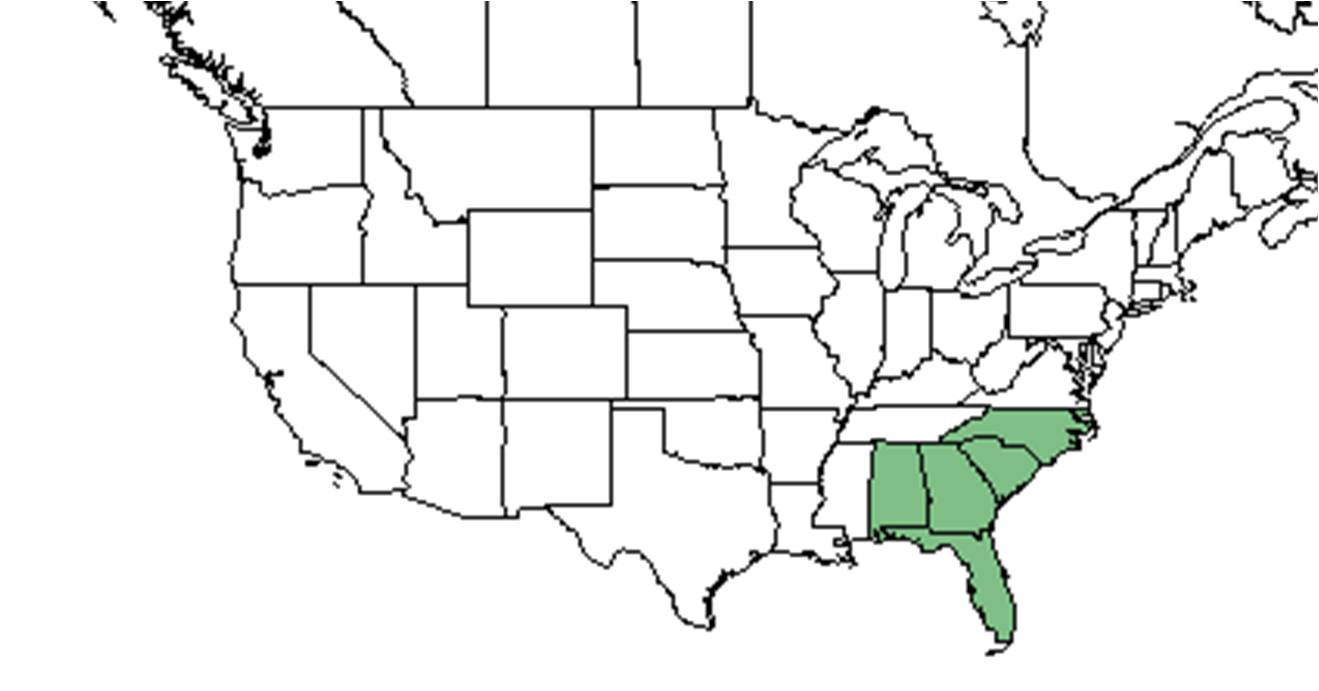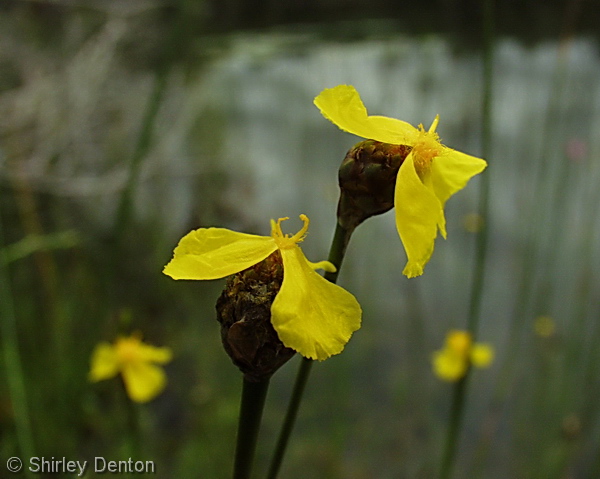Difference between revisions of "Xyris elliottii"
(→Photo Gallery) |
(→Conservation and Management) |
||
| Line 51: | Line 51: | ||
===Diseases and parasites=== | ===Diseases and parasites=== | ||
==Conservation and Management== | ==Conservation and Management== | ||
| + | The primary threats to ''Xyris elliottii'' is mainly mismanagement of the habitat where it thrives. Mismanagement practices include fire suppression, conversion to agriculture, monoculture plantations (such as ''Pinus elliottii''), highway development, and urban sprawl. If this species were to become threatened or endangered, practicing ideal land management by protecting its habitat would help conserve the species<ref name="redlist">[[http://www.iucnredlist.org/details/44392390/0 ]]IUCN Red List. Accessed: March 15, 2016.</ref>. | ||
| + | |||
==Cultivation and restoration== | ==Cultivation and restoration== | ||
==Photo Gallery== | ==Photo Gallery== | ||
Revision as of 15:51, 15 March 2016
| Xyris elliottii | |
|---|---|

| |
| Photo by Shirley Denton (Copyrighted, use by photographer’s permission only), Nature Photography by Shirley Denton | |
| Scientific classification | |
| Kingdom: | Plantae |
| Division: | Magnoliophyta - Flowering plants |
| Class: | Liliopsida – Monocotyledons |
| Order: | Commelinales |
| Family: | Xyridaceae |
| Genus: | Xyris |
| Species: | X. elliottii |
| Binomial name | |
| Xyris elliottii Chapm. | |

| |
| Natural range of Xyris elliottii from USDA NRCS Plants Database. | |
Common name: Elliott's yelloweyed grass
Contents
Taxonomic notes
Description
A description of Xyris elliottii is provided in The Flora of North America.
Distribution
Ecology
Habitat
Xyris elliotti can occur in floating islands of depression swamps, lake shores, wet pine flatwoods, pine-palmetto flats, dune swales, flatwoods bogs, moist pine barrens, Hypericum marshes, cypress domes, sinkhole lake shores, dune hollows, grass-sedge bogs, cypress-gum swamps, hardwood hammocks, and seepage slopes. It has occurred in disturbed areas such as roadside depressions, drying borrow pit ponds, bulldozed flatwoods, and powerline corridors (FSU Herbarium). Soils types include peaty soil, loamy sand, peaty sand, Mandarin (Typic Haplhumods), Clarendon (Plinthaquic Paleudults), and Pineda and Riviera (Arenic Glossaqualfs) (FSU Herbarium).
Associated species include Decodon, Drosera, Polygala, Spartina patens, Centella asiatica, Lycopodium, Syngonanthus flavidulus, Panicum hemitomon, Scleria reticularis, Rhynchospora, Andropogon, Juncus, Amphicarpum muhlenbergianum, Lycopodium appressum, Lachnocaulon engleri, Syngonanthus flavidulus, Sarracenia flava, Polygala, Rhexia, Rhynchospora, Platanthera nivea, Panicum erectifolia, Aster eryngifolius, Rhexia lutea, Polygala chapmanii, Xyris drummondii, X. fimbriata, Scleria reticularis and Panicum tenerum (FSU Herbarium).
Phenology
Flowers and fruits April through September (FSU Herbarium).
Seed dispersal
Seed bank and germination
Fire ecology
Pollination
The following Hymenoptera families and species were observed visiting flowers of Xyris elliottii at Archbold Biological Station (Deyrup 2015):
Apidae: Apis mellifera, Bombus impatiens
Colletidae: Colletes distinctus
Halictidae: Augochloropsis sumptuosa, Lasioglossum coreopsis, L. nymphalis
Megachilidae: Megachile brevis pseudobrevis
Use by animals
Diseases and parasites
Conservation and Management
The primary threats to Xyris elliottii is mainly mismanagement of the habitat where it thrives. Mismanagement practices include fire suppression, conversion to agriculture, monoculture plantations (such as Pinus elliottii), highway development, and urban sprawl. If this species were to become threatened or endangered, practicing ideal land management by protecting its habitat would help conserve the species[1].
Cultivation and restoration
Photo Gallery
Flowers of Xyris elliottii Photo by Shirley Denton (Copyrighted, use by photographer’s permission only), Nature Photography by Shirley Denton
References and notes
Deyrup, M.A. and N.D. 2015. Database of observations of Hymenoptera visitations to flowers of plants on Archbold Biological Station, Florida, USA.
Florida State University Robert K. Godfrey Herbarium database. URL: http://herbarium.bio.fsu.edu. Last accessed: November 2015. Collectors: Loran C. Anderson, W.W. Baker, Edwin L. Bridges, Paul M. Cassen, A.H. Curtiss, Angus Gholson Jr., Robert K. Godfrey, Ann F. Johnson, Ed Keppner, Lisa Keppner, Mabel Kral, Robert Kral, O. Lakela, S.W. Leonard, William Lindsey, K. MacClendon, T. MacClendon, Sidney McDaniel, Gil Nelson, Steve Orzell, P.L. Redfearn Jr. , Grady W. Reinert, Jean W. Wooten. States and Counties: Florida: Bay, Bradford, Brevard, Calhoun, Charlotte, Citrus, Clay, Collier, Escambia, Franklin, Gilchrist, Gulf, Hernando, Hillsborough, Indian River, Jackson, Jefferson, Lafayette, Lake, Lee, Leon, Levy, Liberty, Marion, Martin, Okaloosa, Orange, Osceola, Palm Beach, Pasco, Polk, Putnam, Santa Rosa, Sarasota, St. Lucie, St. Johns, Sumter, Taylor, Volusia, Wakulla, Walton, Washington. Countries: Belize.Compiled by Tall Timbers Research Station and Land Conservancy.
